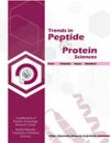فهرست مطالب
Trends in Peptide and Protein Sciences
Volume:1 Issue: 3, May 2017
- تاریخ انتشار: 1396/06/02
- تعداد عناوین: 6
-
Pages 88-98Stereo-selectivity is an important feature in the development of the synthesis of biologically active organic compounds. In this process, (bio) catalysts exhibit substrate specificity that allows high levels of chemo- and regio-selectivity. Over the past decade, several peptides have been developed as effective bio-catalysts for a range of synthetically valuable reactions. In comparison with proteins owing a large number of amino acids and high molecular weights, peptide-catalysts possess only a few amino acid residues, which may adopt a secondary structure suitable for synthesis of desired chiral products. In addition, the flexible nature of peptides consents for tuning of reactivity and selectivity by replacing amino acid residues. These unique aspects provide attractive biocatalysts platform for asymmetric syntheses.Keywords: Peptide, Organic synthesis, Enzyme, Stereo-selectivity
-
Pages 99-108Molecular imprinting described as a method utilized to create artificial receptors and antibodies by construction of selective recognition sites in a synthetic polymer can be a promising tool for generating peptide and protein artificial specific recognition sites. These materials, as potential antibody substitutes, have attracted great interest and attention in different fields such as peptide and protein purification and separation, chemical/electrochemical/optical sensors/biosensors, chromatographic stationary phases, and enzyme mimics. This review has focused on fundamentals of molecularly imprinted polymers in terms of selection of molecular template, functional monomer, cross linker, and polymerization format. Furthermore, several applications of peptide/protein-imprinted materials are highlighted and challenges regarding the intrinsic properties of peptide/ protein imprinting have been emphasized.Keywords: Molecular imprinting, Peptides, Proteins, Recognition, Artificial Antibodies
-
Pages 109-114Today, nanotechnology has paved the way for developing a new generation of delivery systems for potential drugs, proteins, peptides, and genes of interest. This effort reviews a couple of recent reports on application of gold nanoparticles in protein/peptide delivery, with a glance at toxicological aspects of nanoparticles and potential challenges in the upcoming future.Keywords: Gold Nanoparticles, Nanocarrier Systems, Peptide Deliver, Toxicity
-
Pages 115-122In the context of diabetes, there is a bidirectional relation between AGEs and ROS which is amplified under hyperglycemic condition. Indeed, the AGE/RAGE interaction, via triggering several signaling pathways underlies such interplay. These damaging signaling cascades could be attenuated by naturally occurring soluble form of RAGE, namely sRAGE. In the present study, the effect of AGEs on the intracellular superoxide anion level and the antioxidant defense system was studied. Moreover, the link between the level of soluble RAGE and the AGE-triggered signaling pathways, namely ERK, was also investigated. Our results demonstrated that the elevation in intracellular superoxide anion level was associated with decrease in antioxidant enzyme activities. Our data also revealed that the level of sRAGE is negatively correlated with the ERK expression in a hyperglycemia model system. Hence, the current study brings about novel evidences suggesting that the level of sRAGE would be under the influence of stress-sensitive signaling pathways.Keywords: Advanced glycation end products, ERK signaling pathway, Reactive oxygen specious, Soluble receptor
-
Pages 123-129Breast cancer is the most prevalent diagnosed cancer and the second cause of cancer death among women worldwide. There are different mechanisms that play crucial roles in the onset and progression of breast cancer including microRNAs. microRNAs are small noncoding RNAs that regulate gene expression by repressing translation post-transcriptionally. miR-31 is an integrin modulator implicated in different cellular processes such as apoptosis, cell cycle control, and DNA repair. According to the literature, RhoA is one of the genes regulated by miR-31. It has an important role in actin-myosin contraction and subsequently in cell motility and migration in metastasis cascade. Breast cancer cell lines, MCF-7 and MDA-MB-231, as well as normal breast cells, MCF-10A, were cultured. RNA extraction, cDNA synthesis, and SYBR Green I quantitative real-time PCR were used to investigate the expression of miR-31 and RhoA. In addition, 10 metastatic breast cancer clinical samples were analyzed to assess miR-31 and RhoA expression, and normal cells from the same patients were used as controls. Pearsons correlation co-efficient was applied to find out any probable relation between miR-31 and RhoA expression. Gene expression analyses in MCF-7 cell line showed downregulation of miR-31 while RhoA was upregulated in the cell line (inverse correlation). miR-31 and RhoA were both upregulated in metastatic MDA-MB-231 cell line and downregulated in 90% of clinical samples. Pearsons correlation co-efficient showed complete positive correlation between miR-31 and RhoA expression. The expression of miR-31 and RhoA is positively correlated, and it is declined in metastatic breast that cancer clinical samples save MDA-MB-231 cells. Unlike previous reports, we found that miR-31 is not the main silencer of RhoA expression. Therefore, more investigation on genes and miRNAs affecting metastasis process can elucidate new biomarkers and therapeutic targets for metastatic breast cancer.Keywords: miR-31, RhoA, Breast cancer, Metastasis
-
Pages 130-134Organic selenium compound such as selenomethionine plays a significant function in response to oxidative stress. Currently Saccharomyces cerevisiae is one of the best organisms that has ability to accumulate selenomethionine and selenium biotransformation. Addition of mineral selenium to medium culture is a very common practice in order to produce the selenomethionine and Seleno-proteins. Due to the toxicity of selenium for yeasts, selenium tolerant yeast isolation procedures are required. The aim of this investigation was to separate indigenous selenium tolerant S.cerevisiae strains which will not be affected by high selenium concentrations and are able to produce high levels of selenomethionine. In this study, 85 samples were collected from fermentative fruit. Screening was carried out in order to select high yeast cell density and also high selenomethionine accumulation. After confirming yeast strains, selected strains were cultured at a concentration of 25 mg/L sodium selenite and selenomethionine content was measured after 48 hours. The S18 isolate showed had maximum biomass production and selenomethionine accumulation (2655 ppm) and (3.73 g/L) compared to the other isolates.Keywords: Biotransformation, Selenium, Selenomethionine, Seleno-protein, Yeast


